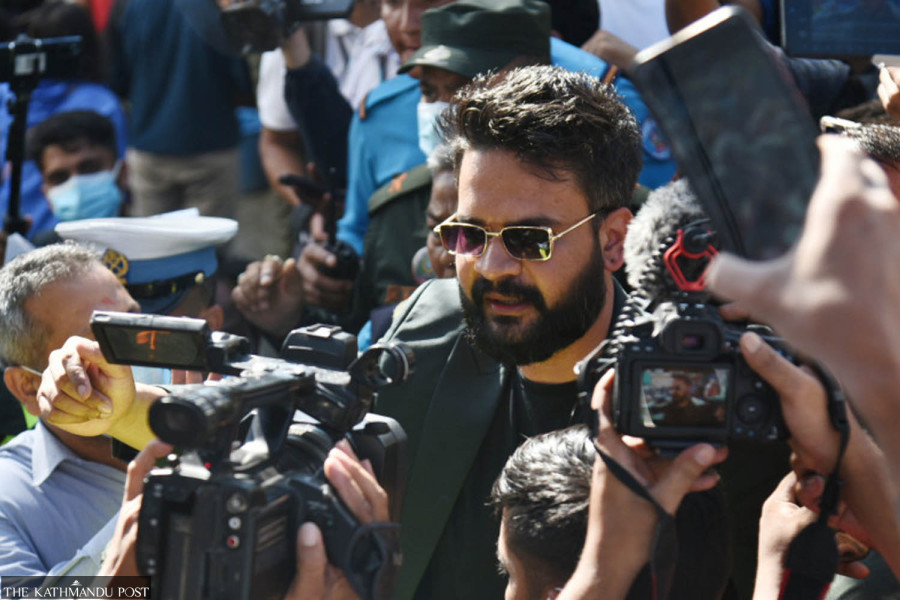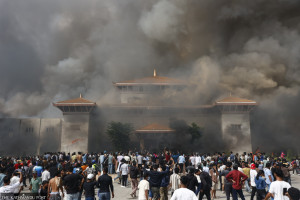Kathmandu
Shah’s shoot-from-the-hip approach missing its mark
Of late, the KMC has had to backtrack on several of its key measures, most recently on Thapathali squatter settlement.
Anup Ojha
Kathmandu Mayor Balendra Shah has found himself in hot water of late. One after another of his actions have come under public scrutiny, the latest being his attempt to remove squatters from the Bagmati river banks in Thapathali. The City police, mobilised by Shah, faced strong fightback from the squatters and had to make a hasty retreat. This action not only agitated the squatters, but also divided the society on the merits of his move.
KMC officials, urban planners and other experts closely observing Shah’s activities said he has failed to bring about intended results due to the lack of study, preparation, consultations with KMC colleagues and stakeholders.
They said most causes Shah has taken up are old cases that have already been complicated by the missteps of KMC or other government bodies. They blamed Shah for further complicating the issues.
Some have applauded Shah for his “much-needed action” that was necessary to remove “illegal settlers” from public land, while others have termed it “immature and inhuman.”
A few days after failing to make any headway on the squatters issue, Shah decided to discuss the matter at the KMC and consult government bodies and other stakeholders before taking further action.
In the past six months, Mayor Shah has waded into more than half a dozen issues. Besides the squatter’s problem, he declared to resolve the garbage problem, tried to evacuate footpath traders, started removing digital hoarding boards, dug out Tukucha River and decided to make an underground parking lot in Khula Manch. All these were controversial moves.
Urban planners and his colleagues at the City office accused Shah, who was elected the Mayor in May, of resorting to “populism” rather than successfully completing pending jobs.
“If we look at Shah's past six months, instead of resolving easiest tasks first, he stepped right into complicated matters that need to be handled tactfully and only after proper research,” said former government secretary Kishor Thapa, who is also an urban planner.
“The squatter problem is a complicated one, with social, political and economic ramifications. Before going into the squatter settlement, the City leadership should have studied past experiences and cases.”
Quickly after being elected, Shah had announced that he would solve Kathmandu’s perennial garbage problem. The KMC said it would start segregating waste from July 17. The decision was widely appreciated. Households started segregating waste as requested, but KMC itself failed to collect it separately. Local officials then admitted that the waste disposal plan had been launched in haste. The City had made a similar (unmet) promise in January 2020, during the tenure of former mayor Bidya Sundar Shakya.
Shah’s administration had also announced plans to convert organic waste into manure, but that too has not materialised.
“If only the City had concentrated its efforts on solving the garbage problem first, it would have succeeded,” Thapa said. “But without completing that, it waded into other, more complicated matters.”
Shah was appreciated for starting a drive to demolish structures built on encroached public land in August.
However, people were divided over his decision to remove footpath hawkers, just before major festivals of Dashain and Tihar.
In the first week of September, the City announced it’d remove all illegal hoarding boards from public spaces. The City shut down digital advertising boards at the World Trade Centre in Tripureshwar, and announced that it would clear other such boards, but a few weeks later, it backtracked.
Then, Shah reached Tukucha River, calling it a ‘new discovery’ of the lost river in the second week of September, and announced that the City would demolish houses built over the river. However, the Patan High Court asked the City not to demolish such buildings encroaching on the river bank. In the following month, the Department of Archaeology sent a letter to the City not to touch the area that apparently had archaeological value.
Even though the City re-introduced a ban on smoking and chewing tobacco in public places in mid-September, that too has not been implemented.
“I don’t see any bad intent in his work, but before he takes decisions, he should look at things in a holistic way and try to find sustainable solutions to whatever he does,” said Suman Maher Shrestha, another urban planner.
The mayor was praised for raising Rs17 million in entertainment tax from the Bhrikutimandap-based Kathmandu Funpark within 24 hours in the first week of September, and also for bringing some of the activities of Nepal Army and Nepal Police under the tax net. But conservationists have objected to his decision to approve a proposal to prepare a detailed project report for a three-storey underground parking and a water recharge pit at the historical Khula Manch.
Bhairam Khadgi, chair of Kathmandu metropolis’s ward 28, said the mayor didn’t consult him on Khula Manch even though the area falls under his ward’s jurisdiction. After the mayor’s decision, conservationists submitted a memorandum to Khadgi, demanding that he protect the public space.
In a conversation with the Post after getting the memo from conservationists, Khadgi said Khula Manch should be left untouched and the City should find other alternatives for a parking lot.
Last week, businesspersons took to the streets against the KMC’s decision to ban roadside parking.
Also last week, Shah mobilised a large number of City police at the squatter settlement in Thapathali to demolish their shacks. But, a big number of squatters retaliated against the City’s eviction attempts, injuring more than a dozen, including City police chief Raju Nath Pandey. The Thapathali squatter settlement has 145 households with 900 people.
Immediately after Shah’s action, the National Land Commission accused the KMC of demolishing the settlement without an alternative arrangement, and also asked not to intervene in its data collection and verification of genuine landless squatters. Thereafter, the City held an executive meeting where many of the elected ward representatives raised questions over Shah’s “immature decision” and the consequences faced by the City police.
Following the backlash, the City backtracked and announced that it would discuss the squatter problem with government agencies and authorities before it initiates another eviction measure.
In May 2012, the Baburam Bhattarai-led government had demolished as many as 251 squatter huts at the same settlement by deploying over 1,000 security personnel. To relocate squatters, the government had then built a settlement at Ichangu Narayan in Nagarjun hills, spending Rs230 million, but those apartments have not been used for the purpose.
Mayor Shah announced to broadcast live the KMC’s executive meetings and he honoured his pledge—until the squatter incident happened whereupon the KMC stopped live telecast of the meetings.
“Both the issues of resettlement of squatters and underground parking in Khula Manch were planned and also discussed during the tenure of former mayor Keshav Sthapit [who won mayoral election in 1997],” said Thapa.
“The efforts of Mayor Shah give people hope, but his works lack an administrative approach and call for more introspection,” said Shrestha, the urban planner. “Shah should start any work only when he is confident of its successful completion so that he does not have to backtrack.”
However, Bhoopdev Shah, secretary of Mayor Shah, claimed that they were quite confident of completing the tasks they had undertaken, despite the hurdles. “It is too early to judge our actions,” he said. “We will take all these tasks to their logical conclusion.”




 15.12°C Kathmandu
15.12°C Kathmandu.jpg)











